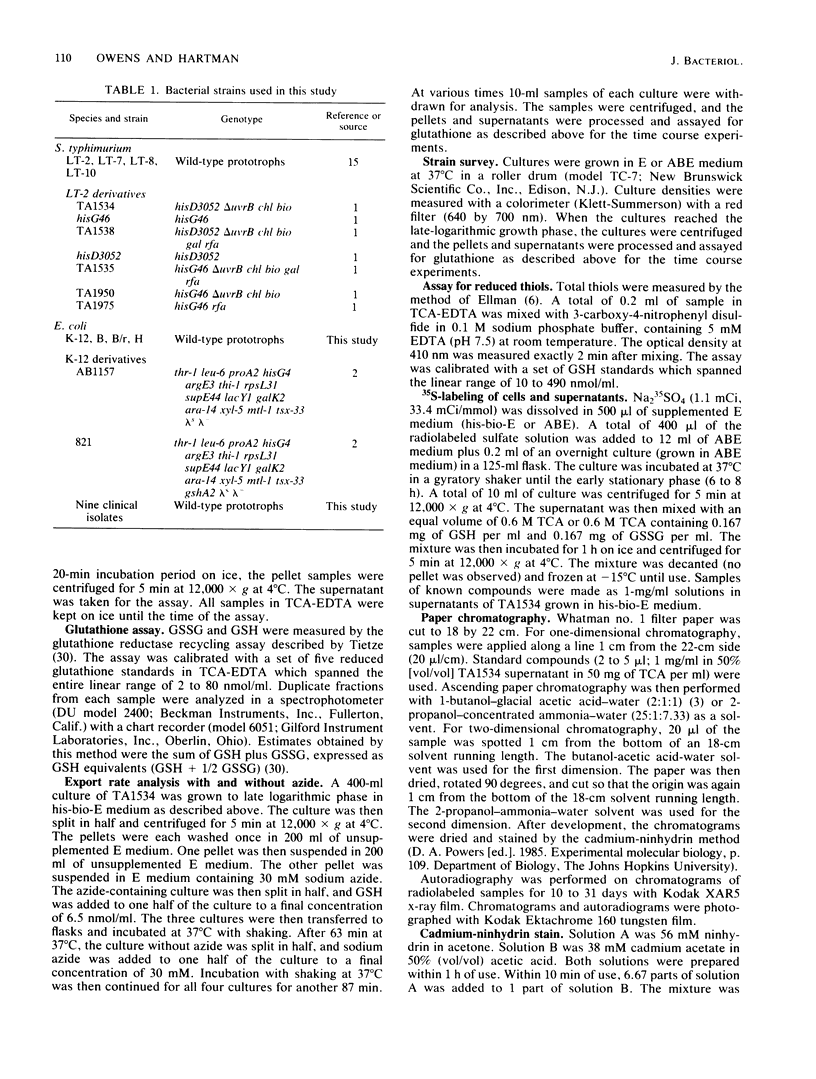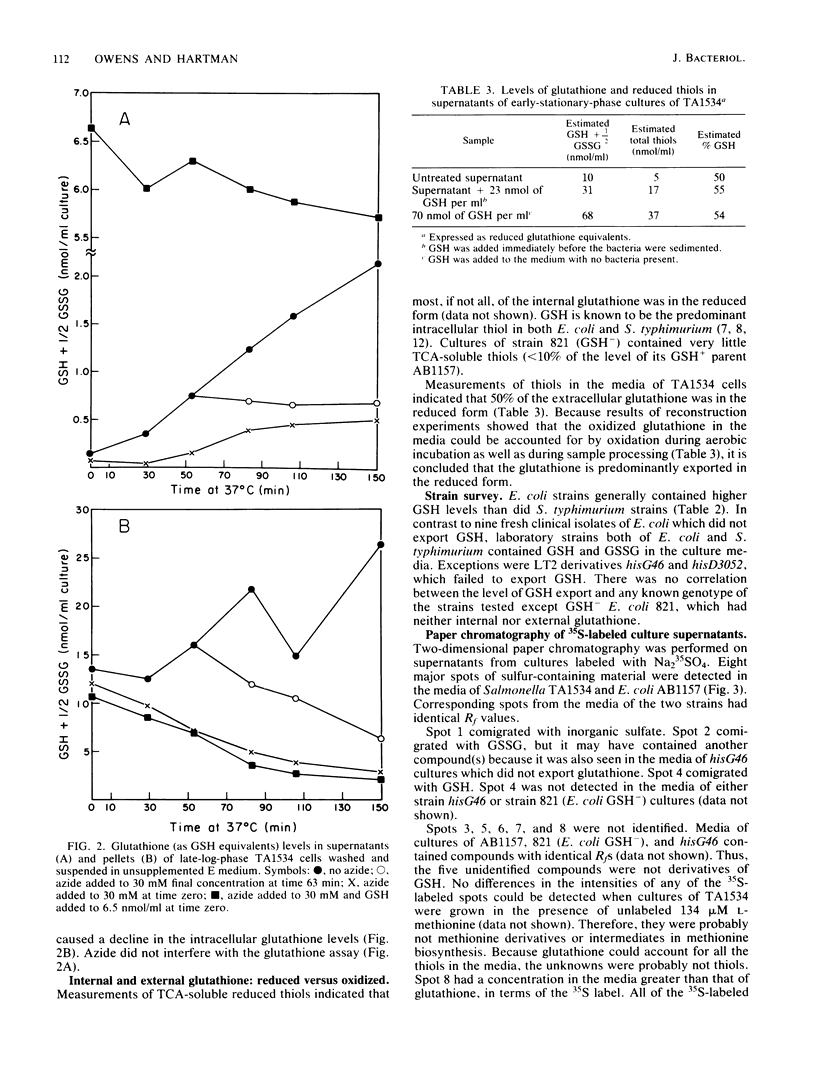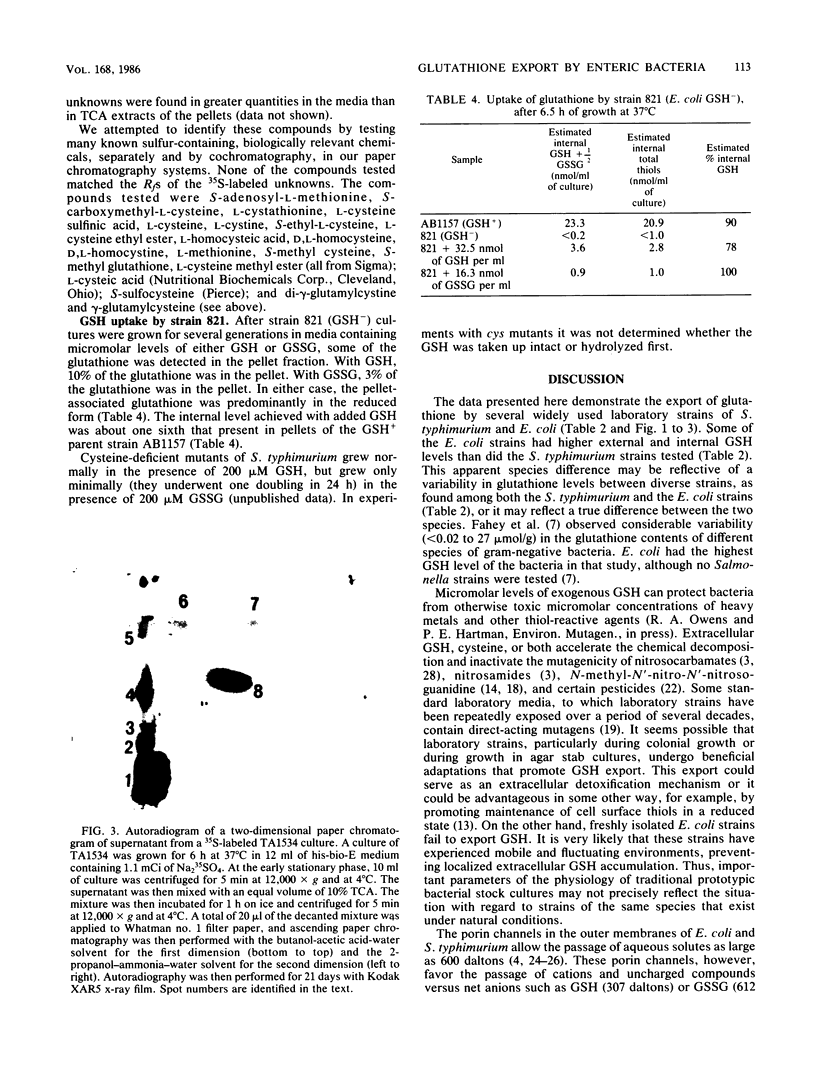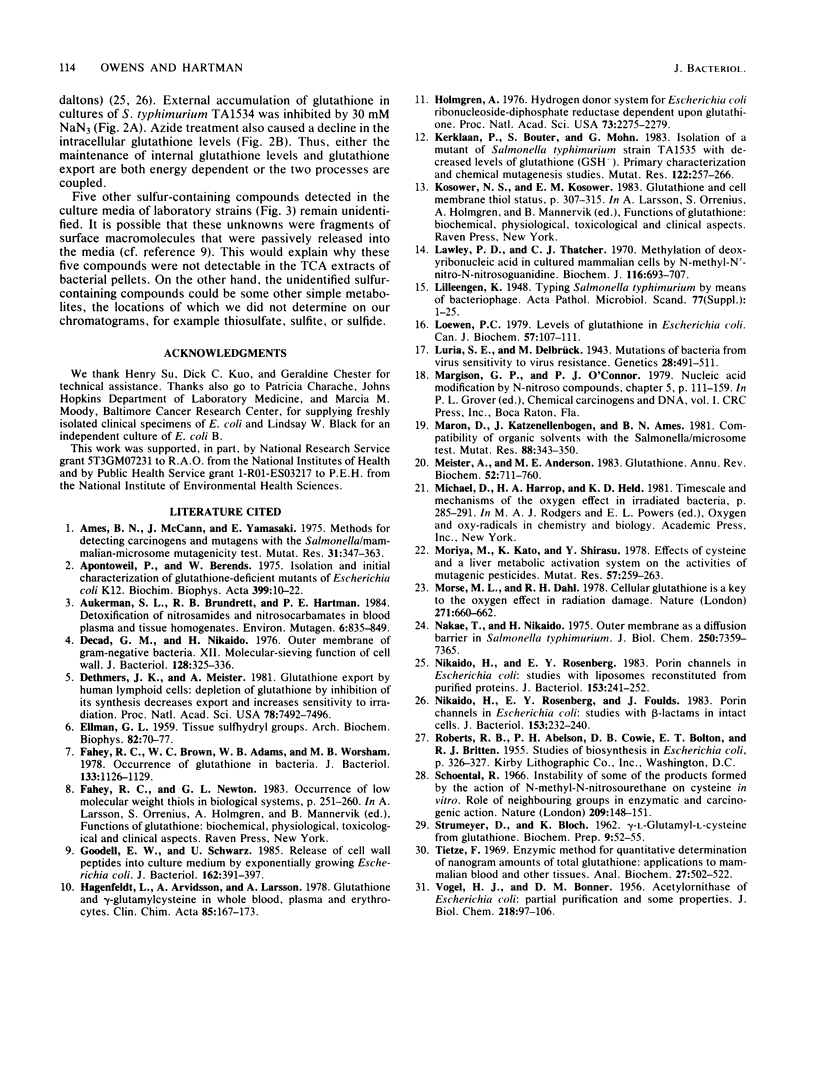Abstract
Significant levels of extracellular glutathione (GSH) were detected in aerobically grown cultures of some strains of Salmonella typhimurium LT-2 and in Escherichia coli K-12, B, and B/r but not in cultures of nine freshly isolated clinical isolates of E. coli. Cultures of S. typhimurium generally contained less total GSH (intracellular plus external) than did E. coli cultures. S. typhimurium TA1534 contained about 2 mM intracellular GSH and exported about 30% of its total GSH. The external GSH concentration increased logarithmically during exponential growth and peaked at about 24 microM in early-stationary-phase cultures. External accumulation of GSH was inhibited by 30 mM NaN3. GSH was predominantly exported in the reduced form. Two-dimensional paper chromatography of supernatants from cultures labeled with Na2(35)SO4 confirmed the presence of GSH and revealed five other sulfur-containing compounds in the media of S. typhimurium and E. coli cultures. The five unidentified compounds were not derivatives of GSH.
Full text
PDF





Images in this article
Selected References
These references are in PubMed. This may not be the complete list of references from this article.
- Ames B. N., Mccann J., Yamasaki E. Methods for detecting carcinogens and mutagens with the Salmonella/mammalian-microsome mutagenicity test. Mutat Res. 1975 Dec;31(6):347–364. doi: 10.1016/0165-1161(75)90046-1. [DOI] [PubMed] [Google Scholar]
- Apontoweil P., Berends W. Isolation and initial characterization of glutathione-deficient mutants of Escherichia coli K 12. Biochim Biophys Acta. 1975 Jul 14;399(1):10–22. doi: 10.1016/0304-4165(75)90206-8. [DOI] [PubMed] [Google Scholar]
- Aukerman S. L., Brundrett R. B., Hartman P. E. Detoxification of nitrosamides and nitrosocarbamates in blood plasma and tissue homogenates. Environ Mutagen. 1984;6(6):835–849. doi: 10.1002/em.2860060610. [DOI] [PubMed] [Google Scholar]
- Decad G. M., Nikaido H. Outer membrane of gram-negative bacteria. XII. Molecular-sieving function of cell wall. J Bacteriol. 1976 Oct;128(1):325–336. doi: 10.1128/jb.128.1.325-336.1976. [DOI] [PMC free article] [PubMed] [Google Scholar]
- Dethmers J. K., Meister A. Glutathione export by human lymphoid cells: depletion of glutathione by inhibition of its synthesis decreases export and increases sensitivity to irradiation. Proc Natl Acad Sci U S A. 1981 Dec;78(12):7492–7496. doi: 10.1073/pnas.78.12.7492. [DOI] [PMC free article] [PubMed] [Google Scholar]
- ELLMAN G. L. Tissue sulfhydryl groups. Arch Biochem Biophys. 1959 May;82(1):70–77. doi: 10.1016/0003-9861(59)90090-6. [DOI] [PubMed] [Google Scholar]
- Fahey R. C., Brown W. C., Adams W. B., Worsham M. B. Occurrence of glutathione in bacteria. J Bacteriol. 1978 Mar;133(3):1126–1129. doi: 10.1128/jb.133.3.1126-1129.1978. [DOI] [PMC free article] [PubMed] [Google Scholar]
- Goodell E. W., Schwarz U. Release of cell wall peptides into culture medium by exponentially growing Escherichia coli. J Bacteriol. 1985 Apr;162(1):391–397. doi: 10.1128/jb.162.1.391-397.1985. [DOI] [PMC free article] [PubMed] [Google Scholar]
- Hagenfeldt L., Arvidsson A., Larsson A. Glutathione and gamma-glutamylcysteine in whole blood, plasma and erythrocytes. Clin Chim Acta. 1978 Apr 17;85(2):167–173. doi: 10.1016/0009-8981(78)90236-x. [DOI] [PubMed] [Google Scholar]
- Holmgren A. Hydrogen donor system for Escherichia coli ribonucleoside-diphosphate reductase dependent upon glutathione. Proc Natl Acad Sci U S A. 1976 Jul;73(7):2275–2279. doi: 10.1073/pnas.73.7.2275. [DOI] [PMC free article] [PubMed] [Google Scholar]
- Kerklaan P., Bouter S., Mohn G. Isolation of a mutant of Salmonella typhimurium strain TA1535 with decreased levels of glutathione (GSH-). Primary characterization and chemical mutagenesis studies. Mutat Res. 1983 Dec;122(3-4):257–266. doi: 10.1016/0165-7992(83)90004-0. [DOI] [PubMed] [Google Scholar]
- Lawley P. D., Thatcher C. J. Methylation of deoxyribonucleic acid in cultured mammalian cells by N-methyl-N'-nitro-N-nitrosoguanidine. The influence of cellular thiol concentrations on the extent of methylation and the 6-oxygen atom of guanine as a site of methylation. Biochem J. 1970 Feb;116(4):693–707. doi: 10.1042/bj1160693. [DOI] [PMC free article] [PubMed] [Google Scholar]
- Loewen P. C. Levels of glutathione in Escherichia coli. Can J Biochem. 1979 Feb;57(2):107–111. doi: 10.1139/o79-013. [DOI] [PubMed] [Google Scholar]
- Luria S. E., Delbrück M. Mutations of Bacteria from Virus Sensitivity to Virus Resistance. Genetics. 1943 Nov;28(6):491–511. doi: 10.1093/genetics/28.6.491. [DOI] [PMC free article] [PubMed] [Google Scholar]
- Maron D., Katzenellenbogen J., Ames B. N. Compatibility of organic solvents with the Salmonella/microsome test. Mutat Res. 1981 Apr;88(4):343–350. doi: 10.1016/0165-1218(81)90025-2. [DOI] [PubMed] [Google Scholar]
- Meister A., Anderson M. E. Glutathione. Annu Rev Biochem. 1983;52:711–760. doi: 10.1146/annurev.bi.52.070183.003431. [DOI] [PubMed] [Google Scholar]
- Moriya M., Kato K., Shirasu Y. Effects of cysteine and a liver metabolic activation system on the activities of mutagenic pesticides. Mutat Res. 1978 May;57(2):259–263. doi: 10.1016/0027-5107(78)90276-2. [DOI] [PubMed] [Google Scholar]
- Morse M. L., Dahl R. H. Cellular glutathione is a key to the oxygen effect in radiation damage. Nature. 1978 Feb 16;271(5646):660–662. doi: 10.1038/271660a0. [DOI] [PubMed] [Google Scholar]
- Nakae T., Nikaido H. Outer membrane as a diffusion barrier in Salmonella typhimurium. Penetration of oligo- and polysaccharides into isolated outer membrane vesicles and cells with degraded peptidoglycan layer. J Biol Chem. 1975 Sep 25;250(18):7359–7365. [PubMed] [Google Scholar]
- Nikaido H., Rosenberg E. Y., Foulds J. Porin channels in Escherichia coli: studies with beta-lactams in intact cells. J Bacteriol. 1983 Jan;153(1):232–240. doi: 10.1128/jb.153.1.232-240.1983. [DOI] [PMC free article] [PubMed] [Google Scholar]
- Nikaido H., Rosenberg E. Y. Porin channels in Escherichia coli: studies with liposomes reconstituted from purified proteins. J Bacteriol. 1983 Jan;153(1):241–252. doi: 10.1128/jb.153.1.241-252.1983. [DOI] [PMC free article] [PubMed] [Google Scholar]
- Schoental R. Instability of some of the products formed by the action of N-methyl-N-nitrosourethane on cysteine in vitro. Role of neighbouring groups in enzymatic and carcinogenic action. Nature. 1966 Jan 8;209(5019):148–151. doi: 10.1038/209148a0. [DOI] [PubMed] [Google Scholar]
- Tietze F. Enzymic method for quantitative determination of nanogram amounts of total and oxidized glutathione: applications to mammalian blood and other tissues. Anal Biochem. 1969 Mar;27(3):502–522. doi: 10.1016/0003-2697(69)90064-5. [DOI] [PubMed] [Google Scholar]
- VOGEL H. J., BONNER D. M. Acetylornithinase of Escherichia coli: partial purification and some properties. J Biol Chem. 1956 Jan;218(1):97–106. [PubMed] [Google Scholar]



